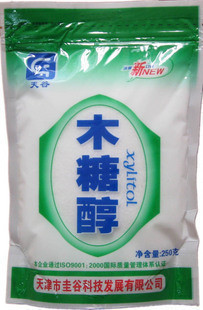Xylitol is a sugar alcohol that is naturally occurring in the human body and is found in many plants. It was originally made for birch but is mostly extracted from corn today. Its taste, color and cooking properties are very similar to cane sugar … but that’s where the comparison ends. In terms of health, xylitol is almost exactly the opposite of sugar and other fructose sources.
Xylitol is a prebiotic that is fermented in the gut creating short chain fatty acids (SCFA) which encourage the growth of good micro-organisms … but sugar and other fructose sources encourage the growth of harmful bacteria and yeasts seriously disturbing gut ecology.
Xylitol is anti-inflammatory … but sugar and other fructose sources are strongly pro-inflammatory.
Xylitol, in some studies, was shown to improve fasting blood glucose levels and post prandial blood glucose levels … but sugar and other fructose sources induce insulin resistance and worsen blood glucose levels.
As little as 7.5 grams of xylitol induced a satiety effect measured at about a 5-8% reduction in calories consumed in one study … but sugar and other fructose sources impair leptin hormonal signaling resulting in increased hunger and weight gain.
Xylitol improves lipid profile resulting in lower triglycerides, higher HDL and lower LDL … but sugar and other fructose sources are turned directly into triglycerides in the liver and worsen the lipid profile.
Xylitol chewing gum is known to prevent tooth decay … but sugar and other fructose sources cause cavities.
Xylitol’s prebiotic function will improve immune function in general and xylitol gum is also known to prevent ear infections … but sugar and other fructose sources can impair immune function.
Xylitol prevents yeast infections … but sugar and other fructose sources encourage the overgrowth of Candida yeast in the intestine, urinary tract and vagina.
Xylitol helps heal an inflamed intestinal lining … but sugar and other fructose sources can destroy the delicate hair-like villi that line the intestine and contribute to a leaky gut.
Xylitol has 40% less calories than sugar and a much lower Glycemic Index.
Xylitol has a clean sweet taste … but sugar and other fructose sources have a sticky sickening sweet taste.
Is xylitol the perfect sugar substitute? Well, maybe not perfect, but I believe it to be the best. Xylitol’s main shortcoming is that some people develop diarrhea and flatulence when they eat too much. Examined closely, this apparent shortcoming is revealing. People who suffer ill effects from xylitol probably have unbalanced gut flora which are not able to digest it. As people who have problems with xylitol gradually increase consumption, the community of micro-organisms in their gut adapts to be able to digest it. In doing this, one’s gut flora greatly improves in other health promoting ways.
The great majority of people who are new to xylitol can eat up to 25 grams (1 ounce) with no ill effects. In one study, participants were given a very large dose of 400 grams a day (almost a pound) of xylitol and more than half of the participants reported no ill effects. The main ill effect reported was flatulence and a smaller number reported diarrhea.
While xylitol has been shown to be absolutely safe and generally healthy for both adults and children, the same cannot be said for all animals. Xylitol is toxic to dogs. This may be serious problem for people who share food with their pets. You cannot give pets any food containing xylitol.
I do not have a dog in my 15th floor apartment, but even if I did, I would not feed it my food. And, like the majority of people, I have no GI issues with xylitol. I have always loved the fresh, natural taste of xylitol compared to some of the odd tasting artificial sweeteners, but I only recently came to understand the prebiotic effects of xylitol. So, for me and most people, maybe xylitol really is the perfect sweetener.



 Where I live in China, xylitol is the most common sugar substitute and is used by almost all diabetics. It costs about $4.00/lb. I note that in the US, it can be purchased online at Swanson Health Products for about $5-9.00/lb.
Where I live in China, xylitol is the most common sugar substitute and is used by almost all diabetics. It costs about $4.00/lb. I note that in the US, it can be purchased online at Swanson Health Products for about $5-9.00/lb.
If you have not tried it, I encourage you to experiment to see if it is for you.
+chronic+disease.jpg)











